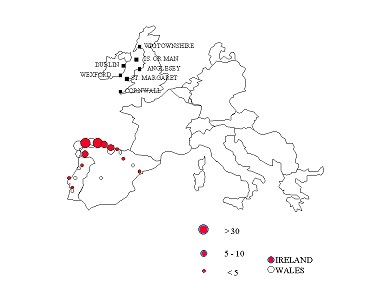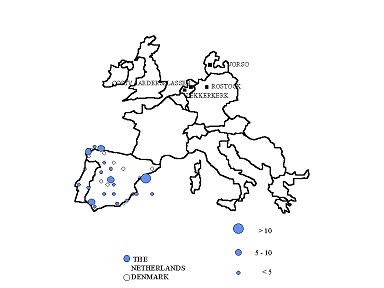 |
 |
| Fig. 1. Recoveries of P. c. carbo in the Iberian Peninsula | Fig. 2. Recoveries of P.c. sinensis in the Iberian Peninsula. |
| WI - Cormorant Research Group | The Bulletin - No. 2, September 1996 | Original papers | |
ORIGIN AND DISTRIBUTION OF THE GREAT CORMORANT Phalacrocorax carbo RECOVERED IN THE IBERIAN PENINSULA
Waldemar Ibarra del Pretti & Juan Antonio Martín Fernández
Introduction
Throughout recent years, numbers of wintering Great Cormorants Phalacrocorax carbo have been increasing in all the Mediterranean countries (Van Eerden & Munsterman 1986, Sánchez García et al. 1987, Munsterman & Van Eerden 1991, Campos & Lekuona 1994), motivated by the great increase of the breeding population in the reproductive areas.
Bernis (1966) described this species' migration in the Iberian Peninsula, but since then, its status has changed considerably. Nowadays, Great Cormorants make a more intensive use of inland areas (Ibarra & Martín 1994), where they even have succeeded in breeding at some sites (Fernández 1991, Gragera 1994, Gómez 1994).
In this report we have examined the migration of wintering Great Cormorants by using 369 recovery cards from ICONA and the Spanish Ornithological Society.
Origin and distribution of Phalacrocorax carbo carbo
Subspecies carbo mainly comes from Ireland and Wales, but in lower numbers also from the western coasts of England and Scotland (Table 1). Most birds of this subspecies have been recovered (or re-sighted) along the Atlantic and Cantabrian coasts of the Iberian Peninsula (Fig. 1). The colonies where these cormorants come from are mainly distributed along the Irish Sea coast (among Ireland's east coast, western Wales and western England as well as southwest Scotland).
Ireland is the country that apports the highest number of birds (52%, n = 133), between Wexford colonies (Little Saltee and Kearagh Island) and Dublin (Lambay), although the Sheep Island's colonies (Co. Antrim) are also represented and a bird of Roundstone (Co. Galway) as well. In the second place some birds from Wales overwinter (33.2%, n = 85), coming mainly from Anglesey (Puffy Island and Pen & Park, Bodorgan) and Tenby (St. Margaret Island), existing references of the Pembrokeshire colonies. Scotland is only represented by 25 birds mainly ringed in Monchrum (Wigtownshire) and from France there are only 5 recoveries that come from the State of Manche and Jersey Island.
There have not been any recoveries from Iceland and Norway, in spite of the great number of birds that nest there and the cormorants' recoveries from these populations that have been registered in England and France.
As far as the wintering areas are concerned, a basically coastal distribution centred in Galicia (77%), Asturias (8.5%) and Cantabria (5%) is noticed, the rest being distributed in an isolated way in the Mediterranean, Portuguese and Basque seabords, with only 6 recoveries in inland areas.
Origin and distribution of Phalacrocorax carbo sinensis
Subspecies sinensis comes mainly from The Netherlands and Denmark. Birds from Germany, Sweden, Belgium and Poland have also been recorded, whereas there are no recoveries from the populations of southeastern Europe. This fact supports the division of the European populations (Hansen 1984), and the existence of other migratory routes for these cormorants (Van Eerden & Munsterman 1986).
Most of the sinensis birds recovered in the Iberian Peninsula come from The Netherlands, where 46% of the birds has been ringed in Lekkerkerk (Zuid-Holland), 15% in Oostvaardersplassen (Flevoland). Dutch cormorants show a homogeneous dispersion all around the Iberian Peninsula, along the coast as well as in inland areas (Fig. 2). The provinces of Tarragona and Huelva should be highlighted with 15 birds from Zuid-Holland and 8 birds from Oostvaardersplassen respectively. Denmark is the second country in importance (20%). The Vorsø colony (Jylland) is the one that apports most birds with 18.5% of all recovered sinensis birds (Table 2).
 |
 |
| Fig. 1. Recoveries of P. c. carbo in the Iberian Peninsula | Fig. 2. Recoveries of P.c. sinensis in the Iberian Peninsula. |
From Germany there are only 12 recoveries (mainly from Rostock district) and although all of them have been located in coastal areas, birds with colour- rings have been seen in central Spain.
References
Bernis F. 1966. Aves migradoras ibéricas. SEO. Madrid.
Campos F. & Lekuona J.M. 1994. La población invernante de Cormorán Grande (Phalacrocorax carbo) en el norte de España y suroeste de Francia. [Wintering population of Cormorants in North Spain and Southwest France]. Ardeola 41: 13-19.
Coulson J.C. & Brazendale M.G. 1968. Movements of Cormorants ringed in the British Isles and evidence of colony-specific dispersal. British Birds 61: 1-21.
Fernández F.J. 1991. Cormorán Grande (Phalacrocorax carbo). Noticiario Ornitológico. Ardeola 38: 327-328.
Gómez J., Rodriguez A., Aranbarri R., Belamendia G. & Martinez I. 1994. Cormorán Grande. Noticiario Ornitológico. Ardeola 41: 193.
Gragera F. 1994. Cormorán Grande. Noticiario Ornitológico. Ardeola 41: 91.
Hansen K. 1984. The distribution and numbers of the southern Cormorant Phalacrocorax carbo sinensis in Europe. Danks Orn. Foren. Tidsskr. 78: 29-40.
Ibarra W. & Martín J.A. 1994. Análisis de recuperaciones de Cormorán Grande (Phalacrocorax carbo) en la Península Ibérica. [Recoveries of Great Cormorants in the Iberian Peninsula]. XII Jornadas Ornitológicas Españolas. Almería, Septiembre, 1994. In press.
Munsterman M. & Van Eerden M.R. 1991. Wintering Cormorants on the fringe of the Mediterranean: possible reasons for long distance travellers. In: M.R. Van Eerden & M. Zjistra (eds) Proc. Workshop 1989 on Cormorants Phalacrocorax carbo: 124-131. Rijkswaterstaat Directorate Flevoland, Lelystad.
Van Eerden M.R. & Munsterman M.J. 1986. Importance of the Mediterranean for wintering Cormorants Phalacrocorax carbo sinensis. In: MEDMARAVIS & X. Monbailliu (eds) Mediterranean Marine Avifauna: 123-141. NATO ASI Series. Series G: Ecological Sciencies 12. Springer Verlag, Berlin.
| COLONIES / COUNTRIES | Nº BIRDS | % |
| Little Saltee, Wexford | 77 | 30.1 |
| Keraragh Island, Wexford | 14 | 5.4 |
| Lambay, Dublin | 31 | 12 |
| Others | 11 | 4.3 |
| EIRE | 133 | 51.9 |
| Puffy Is., Anglesey | 22 | 8.6 |
| Penny Park, Bodorgan, Anglesey | 4 | 1.5 |
| St. Margaret, Tenby | 56 | 21.8 |
| Others | 3 | 1.2 |
| WALES | 85 | 33.2 |
| Mochrum, Wigtownshire | 19 | 7.4 |
| Others | 6 | 2.3 |
| SCOTLAND | 24 | 9.4 |
| ENGLAND | 11 | 4.3 |
| Channel Island | 3 | 1 |
| FRANCE | 5 | - |
| COLONIES / COUNTRIES | Nº BIRDS | % |
| Oostvaardersplassen, Flevoland | 16 | 14.8 |
| Lekkerkerk, Zuid-Holland | 50 | 46.3 |
| Others | 4 | |
| THE NETHERLANDS | 70 | 64.8 |
| Vorsø, Horsens Fjord, Jylland | 20 | 18.5 |
| Others | 2 | 1.8 |
| DENMARK | 22 | 20.3 |
| GERMANY | 12 | 11 |
| POLAND | 1 | 1 |
| SWEDEN | 3 | 2.8 |
Waldemar Ibarra del Pretti & Juan A. Martín Fernández, P° de Móstoles 43, 1° A, Urb. Parque Coimbra, Móstoles, 28935 Madrid, Spain